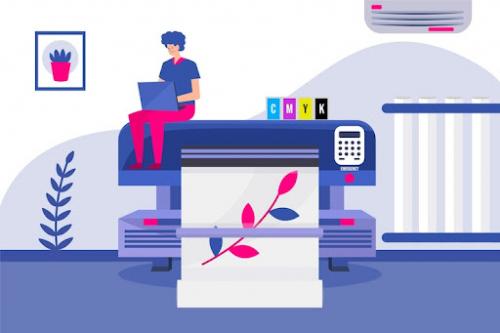The Difference Between Dye-Based And Pigment-Based Inkjet Printing

Inkjet printing is the most commonly used technology for printing on a variety of surfaces, including paper, fabrics, plastics, and more. Inkjet printers use liquid ink, which is sprayed onto the surface to produce high-quality prints.
There are two types of inks used in inkjet printing in NYC - dye-based and pigment-based. In this article, we will explore the differences between dye-based and pigment-based inkjet printing and help you choose the best one for your printing needs.
What is Dye-Based Inkjet Printing?
Dye-based inkjet printing uses liquid dyes that are dissolved in water to produce vibrant and bright colors. These dyes are absorbed into the fibers of the paper, resulting in a quick-drying and high-quality print. Dye-based inks are generally used in photo printers, as they can produce rich and vivid colors that are perfect for printing photographs.
Advantages and Disadvantages of Dye-Based Inkjet Printing:
Advantages:
Vibrant Colors: Dye-based inks produce bright and vivid colors that are perfect for printing photographs and other graphic designs. They are excellent at capturing the nuances of color, making them ideal for printing high-quality images.
Quick Drying: Dye-based inks dry quickly and are less likely to smear, which makes them ideal for printing on glossy paper. This is because they are water-soluble and are absorbed quickly into the paper, leaving a clean and crisp image.
Lower Cost: Dye-based inks are generally cheaper than pigment-based inks, making them a more affordable option for printing. They are widely available and are used in many entry-level inkjet printers.
Disadvantages:
Fading: Dye-based inks are more prone to fading over time, especially when exposed to direct sunlight or UV light. This makes them a less durable option for long-term printing. It's important to note that modern dye-based inks have improved a lot in terms of fade-resistance, but they are still not as durable as pigment-based inks.
Water-soluble: Dye-based inks are water-soluble, which means they can be easily smudged or washed away if they come into contact with water. This makes them unsuitable for printing on materials that are exposed to moisture.
Print Longevity: Dye-based inks have a shorter print longevity as compared to pigment-based inks. They are more suitable for short-term printing, and if you want your prints to last longer, you will have to use specialized paper and take extra care in preserving them.
What is Pigment-Based Inkjet Printing?
Pigment-based inkjet printing uses solid particles of pigment that are suspended in water to produce high-quality prints. Pigment-based inks are more durable than dye-based inks, making them a more popular choice for printing documents, posters, and other materials that require longevity.
Advantages and Disadvantages of Pigment-Based Inkjet Printing:
Advantages:
Longevity: Pigment-based inks have a longer print longevity as compared to dye-based inks, making them ideal for printing documents, posters, and other materials that require longevity. They are resistant to fading and can last for several decades if properly stored.
Waterproof: Pigment-based inks are waterproof and smudge-proof, making them perfect for printing on glossy paper or other water-resistant surfaces. They do not dissolve in water, which makes them ideal for printing on materials that are exposed to moisture.
Fade-resistant: Pigment-based inks are more resistant to fading over time, making them a more durable option for long-term printing. They are perfect for printing archival-quality documents or photographs that need to be preserved for a long time.
Disadvantages:
More Expensive: Pigment-based inks are generally more expensive than dye-based inks, making them a less affordable option for printing. They are used in higher-end inkjet printers, which are generally more expensive than entry-level printers.
Longer Drying Time: Pigment-based inks take longer to dry than dye-based inks, which makes them more prone to smudging or smearing. This is because the pigment particles are larger than dye particles and take longer to be absorbed into the paper. This can be a problem when printing on glossy paper or other materials that require quick drying times.
Limited Color Range: Pigment-based inks are not as vibrant as dye-based inks, and they have a limited color range, which makes them less suitable for printing photographs or other graphic designs. They are better suited for printing documents or posters that require crisp and clear text or simple graphics.
Which one is best for you?
Inkjet printing is a versatile technology that can produce high-quality prints on a variety of surfaces. The choice between dye-based and pigment-based inkjet printing depends on your printing needs.
If you are looking for vibrant and bright colors for printing photographs or other graphic designs, dye-based inkjet printing is the best option. However, if you are looking for longevity and durability, pigment-based inkjet printing is the best option. Pigment-based inks are more suitable for printing documents, posters, and other materials that require longevity and resistance to fading and water.
If you are a professional photographer or graphic designer who requires high-quality prints with vibrant colors, opt for dye-based inkjet printing services in NYC. Dye-based inks are also a more affordable option for printing, making them ideal for casual users who need to print occasionally.
On the other hand, if you need to print documents or other materials that require longevity and durability, pigment-based inkjet printing is the best option. Pigment-based inks are more expensive than dye-based inks, but they are worth the investment if you need to print documents or posters that need to last for a long time.
Both dye-based and pigment-based inks have their advantages and disadvantages, so it's important to weigh them carefully before making a decision. Whatever your printing needs are, there is an inkjet printing option that can meet them.
Post Your Ad Here
Comments